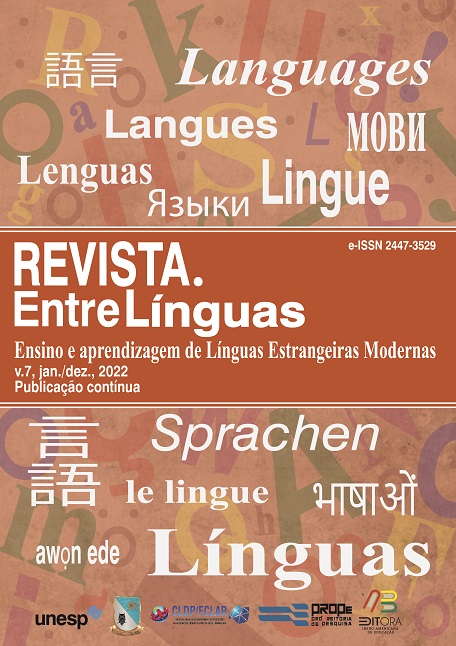O estilo do autor, aspectos linguísticos e de tradução
DOI:
https://doi.org/10.29051/el.v8i00.16660Palavras-chave:
Idiossincrasia, Comparação, Metáfora, Estilo do autor, LingüísticaResumo
O problema da Estilística do autor individual, o seu lugar no sistema de meios verbais já funcionais e o seu papel na realização do potencial pragmático único de uma obra literária e do autor como um todo tornaram-se a base de numerosos estudos no campo da linguística, o que indica a relevância desta obra. O objectivo do artigo é estudar os aspectos linguísticos e de tradução da idiossincrasia do autor. Os métodos. O artigo utilizou métodos científicos: generalização, sistematização e classificação de fontes metodológicas e abordagens científicas do estudo do conceito de “idiosstilo” no sistema de análise linguística de textos literários em obras científicas de investigadores ucranianos e estrangeiros. Resultados. A diferença semântica entre as comparações e metáforas estudadas revelou algum valor semântico destes tropos e as suas funções no estabelecimento de características de género do estilo idiossincrático de Stephen King. Conclusão. A diferenciação estrutural das comparações e metáforas permitiu-nos analisar a frequência da sua utilização nas obras do autor. O tipo mais comum é um grupo de comparações binomiais nominativas, enquanto outros grupos têm aproximadamente o mesmo número de exemplos. Entre as metáforas, o tipo mais utilizado é uma metáfora simples com uma única imagem. A análise do aspecto de tradução das obras de S. King mostra que cada autor utiliza as suas próprias abordagens na tradução de meios léxicos e estilísticos destinados a implementar uma estratégia para criar uma certa atmosfera. Mas é de notar que o mais eficaz é a utilização de meios léxicos e estilísticos próximos do original, enquanto a omissão, a transliteração e muitas vezes a substituição contextual na tradução reduzem a eficácia da criação de certas emoções no leitor. A base para uma maior investigação é determinar abordagens ao estudo da idiossincrasia do autor no género dramático.
Downloads
Referências
ARGAMON, Shlomo; KOPPEL, Moshe. A systemic functional approach to automated authorship analysis. JL & Pol'y, vol. 21, no.(2), p. 299–316, 2012.
BABICH, V. I. Linguostylistic means of expressing the lyrical self at the lexical and grammatical level in a poetic text (based on the materials of idiodiscourses by R. Frost and J. R. R. Tolkien).K. Sandberg). Scientific Bulletin of Kherson State University, vol. 3, p. 109-116, 2017.
BARLOW, M. Individual differences and usage-based grammar. International Journal of Corpus Linguistics, 18(4), 443–478. 2013
CRYSTAL, David. The gift of the gab: How eloquence works. Yale University Press, 2016. 243 p.
EDER, Maciej. Does size matter? Authorship attribution, small samples, big problem. Digital Scholarship in the Humanities, vol. 30, no. 2, p. 167-182, 14 Nov. 2013. Available from: https://doi.org/10.1093/llc/fqt066. Accessed: 7 Apr. 2022.
EDWARDS R. Robert Louis Stevenson on Style in Literature. Classic Articles on Writing, 2019.
ELIOT, Thomas Stearns. Tradition and the Individual Talent. The Sacred Wood. Retrieved. 2015. Available from: http://www.bartleby.com/200/sw4.html 326 Accessed: 7 Apr. 2022.
JOHNSON, Alison; WRIGHT, David. Identifying idiolect in forensic authorship attribution: an n-gram textbite approach. Language and Law (Linguagem e Direito) vol. 1(1), p. 37-69, 2014
KING, Stephen. Carrie. New York, Simon and Schuster, 2000. 208 p.
KING, Stephen. Dreamcatcher. London, Hodder and Stoughton, 2001. 385 p.
KING, Stephen. Everything’s Eventual. Hachette UK, London, 2007 pp. 365-403.
KING, Stephen. The Dead Zone. New York, Simon and Schuster, 2016. 592 p.
KING, Stephen. The Shining. London, Hodder and Stoughton, 2006. 497 p.
LARNER, Samuel. A preliminary investigation into the use of fixed formulaic sequences as a marker of authorship. International Journal of Speech Language and the Law, vol. 21, no. 1, 26 June 2014. Available from: https://doi.org/10.1558/ijsll.v21i1.1. Accessed: 7 Apr. 2022.
AMANN, Janek. Authorship Attribution in Fan-Fictional Texts given variable length Character and Word N-Grams. 2019.
MUTTENTHALER, Lukas; LUCAS, Gordon & AMANN, Janek. Authorship Attribution in Fan-Fictional Texts Given Variable Length Character and Word N-Grams. Notebook for PAN at CLEF 2019, 2019. Available from: http://ceur-ws.org/Vol-2380/paper_49.pdf Accessed: 7 Apr. 2022.
SCHMID, Hans-Jörg. A framework for understanding linguistic entrenchment and its psychological foundations. Entrenchment and the Psychology of Language Learning: How We Reorganize and Adapt Linguistic Knowledge (pp.9–36). Berlin: De Gruyter Mouton, 2016
SHEVKUN, A. Problematic aspects of rendering the author’s idiostyle in the process of translation (based on the novel by I. McEwan “Atonement” and its Ukrainian and Russian translations). International Humanitarian University Herald. Philology, vol. 41, no. 2, p. 182-186, 2019. Available from: https://doi.org/10.32841/2409-1154.2019.41.2.44. Accessed: 7 Apr. 2022.
WRIGHT, David. Using word n-grams to identify authors and idiolects. International Journal of Corpus Linguistics, vol. 22, no. 2, p. 212-241, 22 Sept. 2017. Available from: https://doi.org/10.1075/ijcl.22.2.03wri. Accessed: 7 Apr. 2022.
TYMIAKIN, Leszek. O sztuce reportażu: Aneta Wysocka, Fakty – język – podmiotowość. Stylistyczne osobliwości reportaży Ryszarda Kapuścińskiego, Lublin: Wydawnictwo Uniwersytetu Marii Curie-Skłodowskiej, 2016, 278 s. Etnolingwistyka. Problemy Języka i Kultury, vol. 30, p. 346, 17 Aug. 2018. Available from: https://doi.org/10.17951/et.2018.0.346. Accessed: 7 Apr. 2022.
Downloads
Publicado
Como Citar
Edição
Seção
Licença

Este trabalho está licenciado sob uma licença Creative Commons Attribution-NonCommercial-ShareAlike 4.0 International License.
Os manuscritos aceitos e publicados são de propriedade da Revista EntreLínguas. Os artigos publicados e as referências citadas na Revista EntreLínguas são de inteira responsabilidade de seus autores.
Transferência de direitos autorais – autorização para publicação
Caso o artigo submetido seja aprovado para publicação, já fica acordado que o(s) autor(es) autoriza(m) a UNESP a reproduzi-lo e publicá-lo na EntreLínguas, entendendo-se os termos “reprodução” e “publicação” conforme definição respectivamente dos incisos VI e I do artigo 5° da Lei 9610/98. O artigo poderá ser acessado pela rede mundial de computadores (Internet), sendo permitidas, a título gratuito, a consulta e a reprodução de exemplar do artigo para uso próprio de quem a consulta, desde que haja a citação ao texto consultado. Essa autorização de publicação 328 EntreLínguas, Araraquara, v. 1, n .2, p. 323-328, jul./dez. 2015 não tem limitação de tempo, ficando a UNESP responsável pela manutenção da identificação do(s) autor(es) do artigo. Os artigos publicados e as referências citadas na Revista EntreLínguas são de inteira responsabilidade de seus autores.











